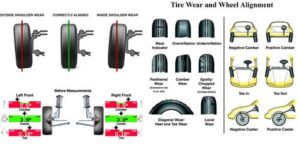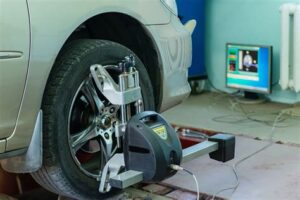Maintaining your vehicle’s performance is essential for a safe and comfortable driving experience, and one crucial aspect of that maintenance is wheel alignment. Have you ever wondered, “How do I know if my car needs an alignment?” Identifying misalignment can not only improve your car’s handling but also extend the life of your tires and enhance fuel efficiency. In this article, we will explore the signs that indicate your car may be out of alignment, understand the importance of proper alignment, and highlight common causes of misalignment. Additionally, we will provide practical tips on checking your car’s alignment at home and advise when it’s time to seek professional help. By being informed, you can ensure your vehicle operates at its best and keep your driving experience smooth and safe.
How Do I Identify Signs Of Misalignment?
Identifying signs of misalignment is crucial for maintaining your vehicle’s performance and safety. Here are some common indicators that your car may be experiencing alignment issues:
- Uneven Tire Wear: If you notice that your tires are wearing out more on one side than the other, it could be a sign of misalignment.
- Steering Wheel Off-Center: When your steering wheel is not centered while driving straight, this often indicates that the wheels are misaligned.
- Pulling to One Side: If your car drifts to the left or right while you are driving on a straight road, it’s a clear sign of alignment problems.
- Vibration in the Steering Wheel: Excessive vibration can be another indicator of misalignment, which may occur when the wheels are not aligned properly.
- Difficulty in Handling: If your car feels unstable or harder to steer than usual, it may be due to misalignment issues.
Regular checks and being aware of these symptoms can help you address alignment issues early, ensuring a smoother ride and extended tire life.
Understanding The Importance Of Proper Wheel Alignment
Proper wheel alignment is crucial for the overall performance and safety of your vehicle. When your car’s wheels are aligned correctly, it ensures that they are pointing in the same direction and that the vehicle travels straight down the road without pulling to one side. This can significantly impact the handling of your car and enhance your driving experience.
One of the primary reasons why maintaining proper alignment is important is its effect on tire lifespan. Misalignment can lead to uneven tire wear, meaning that you may have to replace your tires much sooner than expected. Regularly checking and adjusting your alignment can save you money in the long run by prolonging the life of your tires.
In addition to tire longevity, how do you factor in fuel efficiency? When your wheels are misaligned, your vehicle requires more energy to move forward, leading to decreased fuel efficiency. Keeping your wheels properly aligned can help maximize your fuel economy, allowing you to save on gas expenses.
Furthermore, correct wheel alignment contributes to safer driving conditions. A vehicle that pulls to one side can pose a significant hazard, especially when road conditions are not ideal. Keeping your alignment in check ensures that you have better control over your vehicle, allowing for more stable and confident handling.
Aligning your wheels can help prevent issues with other parts of your car’s suspension system. A well-maintained alignment reduces the stress and strain on suspension components, which can help to avoid costly repairs in the future. Therefore, understanding the importance of proper wheel alignment is not just about comfort and aesthetics; it’s a vital aspect of vehicle maintenance that contributes to safety, efficiency, and cost-effectiveness.
Common Causes That Lead To Car Misalignment
Misalignment in vehicles can stem from various reasons, some of which may not be immediately obvious. Understanding these causes can help you maintain better handling and ensure the longevity of your vehicle’s tires. Below are some of the most common factors that lead to car misalignment:
| Cause | Description |
|---|---|
| Rough Roads | Potholes, speed bumps, and uneven surfaces can jolt your vehicle, leading to misalignment. |
| Accidents | Any collision, even minor ones, can disrupt the alignment of your wheels and suspension. |
| Wear and Tear | Over time, suspension parts, tires, and even the chassis can wear down, affecting alignment. |
| Worn Out Tires | Uneven tire wear can cause misalignment and, if left unchecked, can lead to further handling issues. |
| Improper Installation | If tires or suspension components were not installed correctly, they can affect alignment. |
Being aware of these factors is essential. If you suspect your vehicle’s alignment is off, troubleshooting the common causes listed above will help you determine whether your car needs a thorough check-up. Remember, ignoring signs of misalignment can lead to more extensive damage and costly repairs in the future. If you’re wondering how do I know if my car needs an alignment, keeping these causes in mind is a great starting point.
How Do I Check My Car’s Alignment At Home?
Checking your car’s alignment at home can be a straightforward process, allowing you to catch potential issues before they require professional intervention. Here are several methods you can use to assess your vehicle’s alignment:
- Visual Inspection: Start by parking your car on a flat, level surface. Inspect your tires for any uneven wear patterns, which can be an indicator of misalignment. Look for signs such as bald spots, cupping, or more wear on one side of the tire.
- Steering Wheel Test: Drive your car on a straight, flat road at a slow speed. If your steering wheel is off-center when your vehicle is moving straight, it can indicate a misalignment. The steering should be level, so any deviation could suggest a problem.
- Tracking Test: Take note of your car’s behavior while driving. If you find yourself constantly correcting the steering to keep the car going straight, this may be a sign that the alignment is off.
- The String Method: For a more detailed check, this DIY method can be helpful. Park your car on a flat surface. Use a long piece of string or a fishing line and attach it to the rear wheels. Run it along the sides of the car to check if the front wheels align with the strings. Adjust the strings if necessary to see if there is misalignment.
- DIY Alignment Tools: A simple camber gauge can help you measure the camber of the wheels, while a digital angle finder can assist with caster measurements. These tools can be purchased online or at automotive supply stores.
Keep in mind that while these methods can help you identify potential misalignment issues, they may not provide absolute accuracy compared to professional alignment inspections. If you notice any significant discrepancies, it’s advisable to consult with a trusted mechanic.
When To Seek Professional Help For Alignment Issues
While there are several ways to determine if your vehicle may need an alignment, certain signs and situations indicate that it’s time to seek professional help. Here are some critical scenarios to consider:
- Constant Pulling: If your car consistently pulls to one side while driving, this is a clear indication of misalignment. You should visit a professional immediately to address this issue, as it can affect your ability to steer safely.
- Irregular Tire Wear: If you notice uneven tire wear patterns, such as one side wearing more quickly than the other, it’s a good idea to have a professional inspect your alignment.
- Steering Wheel Off-Center: If your steering wheel is not centered when driving straight, this is a sign that your wheels may be misaligned. A professional alignment can help correct this issue.
- Visual Inspection: If during a routine check or tire rotation, a professional recommends an alignment due to their observations, it’s wise to follow their advice.
- After Suspension or Tire Changes: Anytime you replace suspension components or tires, it’s prudent to have a professional alignment done to ensure everything is in proper order.
Ignoring misalignment can lead to further complications, including poor fuel efficiency and increased wear on your tires and suspension. Therefore, if you experience any of the above symptoms, don’t hesitate to consult a professional. They can provide a thorough evaluation and the necessary alignment service to keep your vehicle running smoothly.
Frequently Asked Questions
What are the common signs indicating my car needs an alignment?
Common signs include uneven tire wear, your steering wheel being off-center when driving straight, pulling to one side while driving, and a crooked steering wheel.
How can I check if my car has uneven tire wear?
You can visually inspect your tires for any irregular patterns, such as bald spots, or different tread depths. Using a tread depth gauge can also help assess tire wear.
Is there a recommended frequency for checking my car’s alignment?
It is generally recommended to check your alignment every 6,000 miles or during routine maintenance, but you should also check it if you notice any signs of misalignment.
What causes a car to become misaligned?
Common causes include hitting potholes, driving over curbs, and normal wear and tear over time that affects suspension components.
Can misalignment affect fuel efficiency?
Yes, misalignment can lead to uneven tire wear and increased rolling resistance, which can negatively impact your fuel efficiency.
How much does a wheel alignment typically cost?
The cost of a wheel alignment usually ranges from $50 to $100, but prices may vary based on your location and vehicle type.
Should I perform a wheel alignment myself or go to a professional?
While basic checks can be done at home, performing a precise wheel alignment generally requires specialized equipment and expertise, making it advisable to visit a professional.





